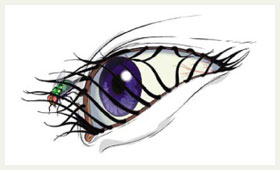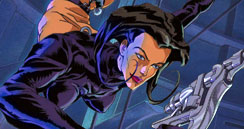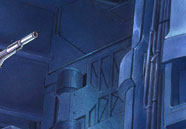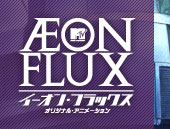 |
 |
 |
 |
 |
 |
 |
Q1:All episodes of Aeon Flux are highly unique, especially earlier “Short Episodes” were amazing, with wonderful episodes created almost like music, with repeated, transformational movements. Could you tell me about the concepts you had when you began this project. |
 |
 |
 |
 |
I believe that the delivery of aesthetic pleasure is the means by which motion pictures can affect the viewer, but that is only the method, not the goal. I'm convinced that works of art can have a lasting effect on the way people regard the time and the culture in which they live. Our culture is defined by our choice of how we portray the world around us as well as how we choose to portray ourselves. I am motivated by the possibility of contributing something to our contemporary mythology-- specifically in the case of Aeon Flux, to frame social and political conflict in terms of personal agendas and the psychology of desire rather than in terms of nationalist identity or some kind of archetypal structure of absolute "good vs. evil" morality, both tendencies which seem to be prevalent in our media. |
 |
 |
 |
 |
Q2:Also fascinating were the movements. Humans in this series move their arms and legs so fast. They move more like insects or machines than like humans. Aeon often poses like a frog sitting still on a leaf. Some characters also move like combinations of insects and human in unique ways. Do these un-human and unusual movements reflect your own interest? Did they come as a result of pursuing appealing motions distinct to animation? |
 |
 |
 |
 |
The style of motion is an attempt to depict an inner expression of character rather than a realistic representation of nature. I believe that drawn images, whether static or moving, need not deny the agency of the artist drawing them. Live actors are obviously much more efficient at capturing naturalistic human movement than an animator's drawings. On the other hand, animated characters can convey an intensity of feeling that is more a direct expression of the character's inner state, or yearning. An athlete or dancer may wish to be able to perform a particular gesture, yet be limited by the limits of physical possibility. I think of my characters as dancers who must convey to the audience their inner states through precise movement. When we watch a dance performance, we don't expect the dancers' movements to reflect the ordinary ways in which average people move. We'd be disappointed if they did. I believe the same applies to an animated character. |
 |
 |
 |
 |
Q3:Do you like insect images? The image of Aeon’s eyelashes with a fly is very impressive. It gives Aeon’s eyelid an impression of a carnivorous plant. We also see many images of living beings and egg-like objects that connote insects. Insects are harder than humans but they are not as hard as machines. Is that in-between existence something that interests you? Or do they appeal because they move in interesting ways? |
 |
 |
 |
 |
  I'm not sure the insect imagery was so much of a conscious choice. More broadly, one idea I deliberately wished to convey was the importance of events happening on a miniature scale. I find that many films attempt to suggest importance by means of staging action on a very large scale. Conversely, I find that I'm usually more drawn into scenes showing tiny details: an overlooked object lying on the ground like a tooth or a nail, or events inside someone's mouth or eye. When the camera focuses on tiny details, you lean forward to examine more closely. When focusing on enormous events, you lean back and become more of an outside observer. I'm a big fan of the Pixar movie "A Bug's Life". I'm particularly fascinated by the specialization of the anatomies of particular insects, in that they visually embody their specific functions like no other types of living creatures. They convey so much of their role through their "design". From the point of view of a designer, they provide much inspiration. I'm not sure the insect imagery was so much of a conscious choice. More broadly, one idea I deliberately wished to convey was the importance of events happening on a miniature scale. I find that many films attempt to suggest importance by means of staging action on a very large scale. Conversely, I find that I'm usually more drawn into scenes showing tiny details: an overlooked object lying on the ground like a tooth or a nail, or events inside someone's mouth or eye. When the camera focuses on tiny details, you lean forward to examine more closely. When focusing on enormous events, you lean back and become more of an outside observer. I'm a big fan of the Pixar movie "A Bug's Life". I'm particularly fascinated by the specialization of the anatomies of particular insects, in that they visually embody their specific functions like no other types of living creatures. They convey so much of their role through their "design". From the point of view of a designer, they provide much inspiration. |
 |
 |
 |
 |
Q4:The images of internal organs were also shocking. Scenes which Aeon tangles her tongue with another person to exchange a small object inside their mouths, or which traveling into a body leads to a different world etc. The smooth curves in these scenes are so intense, we’re seeing a celluloid animation but actually feeling the slimy texture and stickiness of the internal organs. Is this another interest of yours? Or did this come from pursuing eroticism in animation? |
 |
 |
 |
 |
I chose often to focus on tiny details as a way of breeching a barrier, so we feel we are entering a private or forbidden space. To examine a live actor that way may seem like a violation of privacy; as I've said, I think one should take advantage of the freedom afforded by animation by portraying events and actions that would be impossible or impractical to do with live actors. In literature, I enjoy the revelation of extremely intimate, uninhibited thought processes of characters. Because film is a visual medium, we must find an equivalent means of entering that level of intimacy through physical means. That is why the stories in films seem to be concerned with sexual and violent content out of proportion with real life. |
 |






